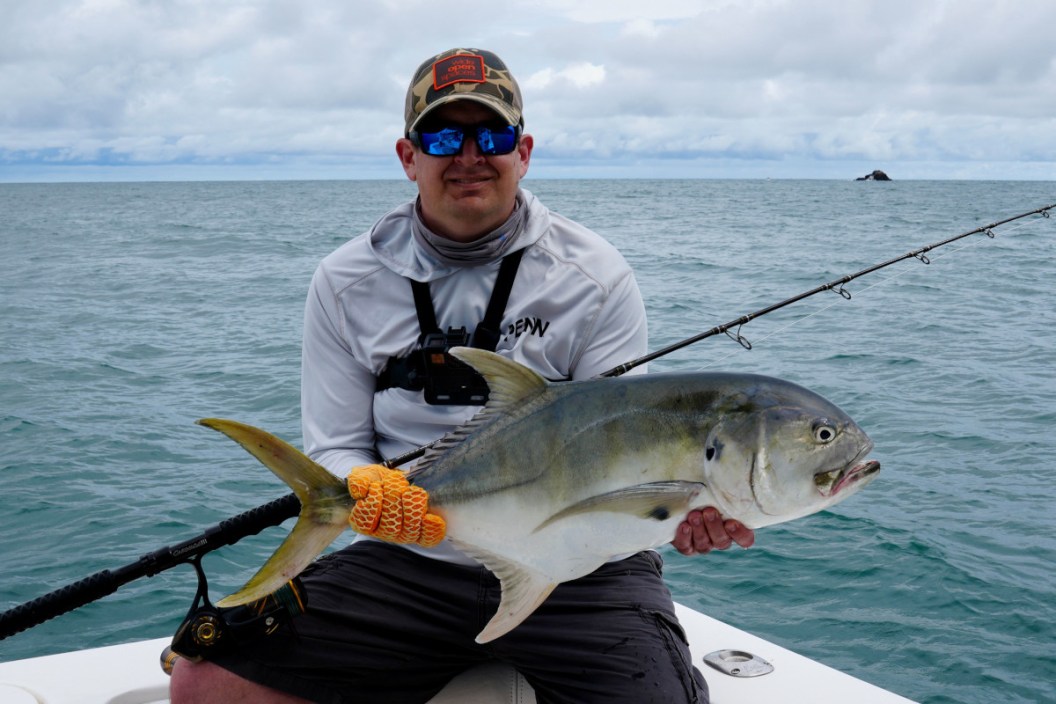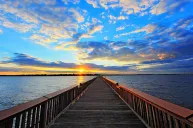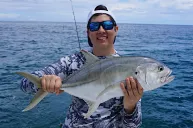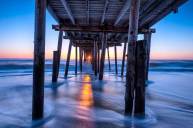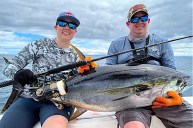My fishing rod was creaking under the weigh. It had been approximately 20 minutes since our captain had put our boat on a school of yellowfin tuna feeding with a group of spinner dolphins in the Pacific Ocean off the coast of Costa Rica. A moment later, the five-foot fish, the first one we'd hooked that morning, made its first appearance next to the boat. As the deckhand got into position with the gaff, the huge tuna sensed danger and immediately dove, peeling line off the spinning reel in a mad dash for the safety of the depths. We didn't see the fish again for nearly 30 minutes after that, as everyone on the boat took turns fighting it.
Finally, the big fish started to tire, and I was able to pull him up next to the boat again. We seized the chance for the captain and deckhand to finally gaff and pull the tuna over the railing. Back at the dock several hours later, the fish weighed in at 91 pounds and measured exactly 60 inches long. It was the biggest fish I'd ever caught, and probably the greatest fishing adventure I'd ever had. The wild thing was it was only day one of this fishing trip.
I quickly learned that Costa Rica is a true angler's paradise, and that it's easier than one might think to head down south an have an experience like this. We talked to employees at one of the top sport fishing resorts in the country to get the full scoop on how others can go about setting up their own trip to Costa Rica, which for me was the trip of a lifetime.
Does Costa Rica Have Good Fishing?
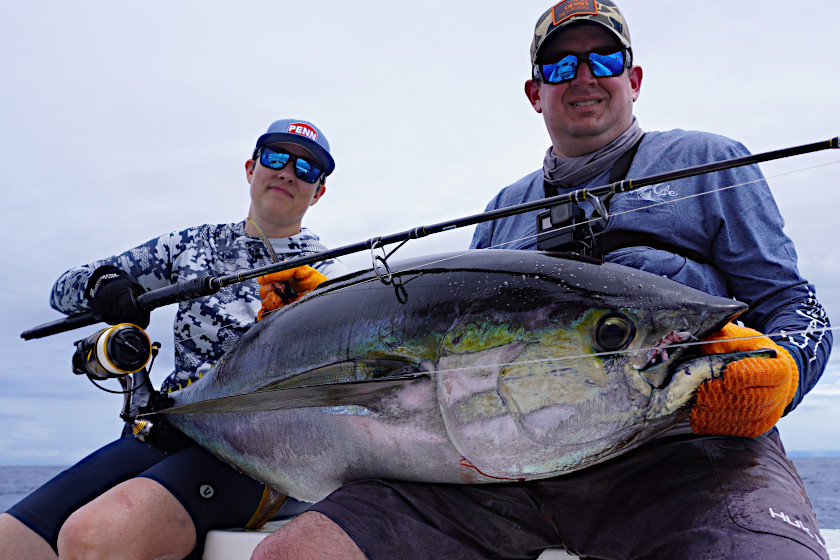
Travis Smola
More anglers than ever are flying to this small Central American country, and it becomes more obvious why the place has become so popular from the first time you step on a fishing charter boat. Almost everything in the country is inexpensive, and most places gladly take U.S. dollars. The scenery is gorgeous, the weather is warm without being too overbearing, and you just never know what's going to be on the other end when line starts peeling off your reel at a high rate of speed. During my trip I tangled with multiple yellowfin tuna after that 91-pounder. I also fought with a feisty Jack Crevalle and landed a roosterfish, albeit a small one. Still, I was grateful to cross those coveted species off my angling bucket list regardless of the size. Costa Rica is also popular for game fish like the dorado, otherwise known as mahi mahi, plus wahoo, bonefish, tarpon, amberjack, multiple varieties of snapper, and more.
While many people come to Costa Rica with an inshore fishing expedition for roosterfish on the brain, it's also a dynamite billfish factory on both the Atlantic and Pacific sides. Blue, black, and striped marlin can all be found there. Crocodile Bay Resort's Director of Fishing, Diego Camacho, told me the population of blue marlin is the strongest. Camacho grew up in the fishing industry, spending time in Florida before coming to Costa Rica. He worked his way up at Crocodile Bay from second mate to Captain, and eventually became Fishing Director. In his opinion, the Pacific and Atlantic coasts offer different experiences based on what an angler is looking for out of their fishing vacation.
"The Pacific sailfish grows a lot larger than the Atlantic sailfish. What I mean by a lot is a 50- to 100-pound difference," Camacho said.
Crocodile Bay's Sales and Marketing Director Mark Carlson agrees. He spent six years as marketing director in Panama at the Tropic Star Lodge before coming north to work at Crocodile Bay, which is considered among the best resorts in the country.
"The Atlantic coast has a lot of good fishing for bonefish, tarpon fishing, lots of tarpon fishing," Carlson said. "The Pacific side is known more for the open water pelagic fish."
Either way, you can't really go wrong; there's world class angling to be had across Costa Rica year round. It makes for a great getaway from the snow and cold of North America during the winter months. Many anglers head down to the Pacific or Caribbean Coast for some offshore fishing while their home is in a deep freeze. Even during June when I visited, I was pleasantly surprised that the rainforest was not as muggy or as sweltering as I had expected. The conditions were great for a fantastic fishing experience.
Costa Rican Fishing License Requirements and Conservation
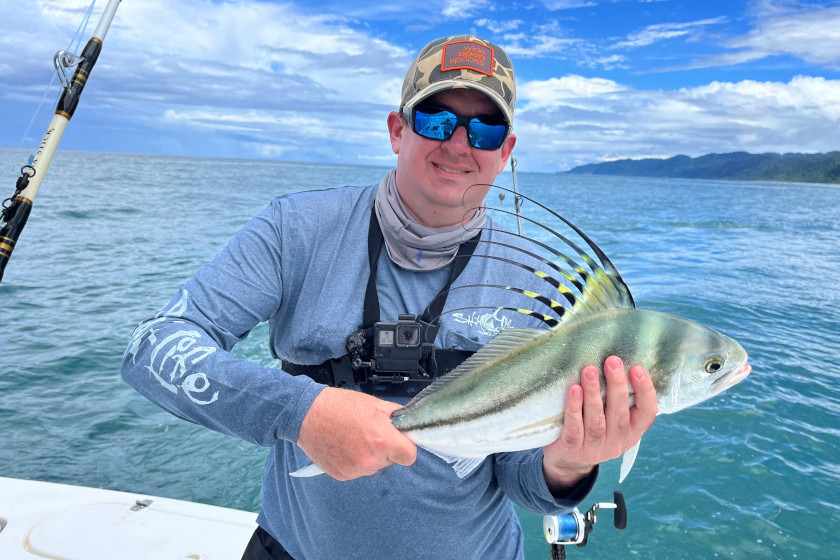
Michelle Gandola
If you're used to bypassing the typical license requirements because you're with a licensed charter, it might surprise you to learn Costa Rica requires everyone who is fishing to hold an individual fishing license. An eight-day license, which will cover the whole trip for most anglers, costs only $16.95 USD. That's $10 less than a year-long residential fishing license where I live in Michigan! Even if you buy a yearly license, it's only $56.50. Costa Rica's fishing licenses may be one of the biggest angling bargains in the world, and they're easy to acquire too. Anglers can do it online before they go, or they can even have a resort like Crocodile Bay purchase it for them in advance of their visit.
Even though it's cheap to make yourself legal for Costa Rica fishing, don't go thinking it's a free-for-all. The Costa Rican government and groups like FECOP (Federation of Sport Fishing in Costa Rica) have worked extremely hard to give the small, demilitarized county an admirable conservation mindset. They've worked to push the commercial fishing operations out further from shore due to ecosystem protection efforts. There are also big public awareness campaigns in the country. It starts from the moment you land and go through customs, with plenty of signs advocating the release of billfish before you even leave the airport. In fact, Costa Rica made a rule that billfish can no longer be taken out of the water to help protect the population.
"There's a lot of reasons behind that, but one of the main reasons why is because when you pull him into the boat, you're pretty much sliding him over the main gunnel of your boat, taking all the slime off his body which is a protective shield for him," Camacho said. "And it'll be within a month or two you create an infection, and of course, they don't have antibiotics out there, so eventually the fish will die."
Costa Rica also strictly controls where anglers are allowed to fish. Some of it might sound restrictive to anglers used to fewer regulations in the states or other international countries.
"Costa Rica prohibited the cast nets, we can't fish the river mouths, we can't fish up the rivers, we can't fish the mangroves," Camacho said. "We have to stay a half a mile away from the National Parks."
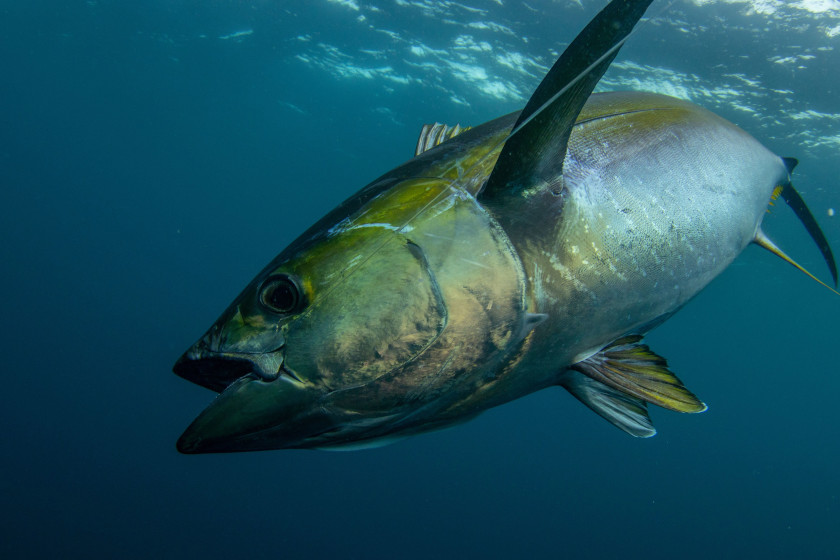
Adrian Gray
However, Carlson said many of the restrictions help make the country a truly special fishing destination, because it limits the number of fishermen encroaching on those sensitive spaces, and allowing the different species to survive and flourish. I couldn't argue with that on day three when my group caught more than a dozen yellowfin tuna, the smallest of the bunch being only a modest 30 pounds. But most of those went back into the sea. Costa Rica is also unique in that they have a five fish per day limit on each boat. That's five fish regardless of species and the number of anglers onboard. It's a simple rule, but one that seems to work.
"We want to promote the catch and release more than anything," Camacho said. "So, the five fish per boat is more than enough. Most of the people that we get here are probably here for five to six days, so one 40-pound tuna will feed them the whole stay."
Costa Rica is also strict on equipment. In fact, many of the baits and tactics people use for deep sea fishing in the states are not legal there. Camacho feels the restrictions are fair because they are established with a bigger picture in mind. For instance, J-hooks can only be used on artificial lures.
"Now any bait that you have in the water has to be in a circle hook, even if it's dead or alive," Camacho said. "All of our pitch baits, all our ballyhoos are run on circle hooks. Which, I really, really like the idea, it helps keep the fish healthy when you're going to release them."
Spearfishing is illegal in Costa Rica, and while anglers are welcome to bring their own equipment, the best resorts are always fully stocked with some of the best rods and reels on the market today. Crocodile Bay regularly partners with Penn Fishing to get the latest and greatest, meaning most anglers only need to pack clothing and a camera. If anyone still does wish to bring and use their own gear, they'll want to make sure to check the regulations. Camacho notes that many of the most popular techniques in U.S. places like Florida are managed under different regulations in Costa Rica.
"A lot of people want to bring the Ilanders. We can use them, but we can only use them with just a straight hook," he said. "No bait in the hook, that's what a lot of people want to do here in Costa Rica, which is pretty normal in the states. But here, it's illegal."
What is the Best Time of Year to Fish Costa Rica?
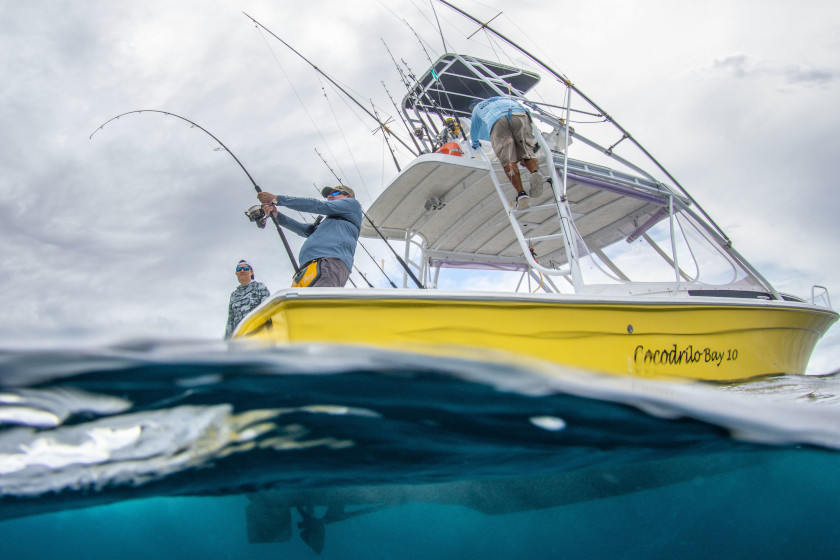
Adrian Gray
The great thing about Costa Rica is there is almost always something biting. Carlson said Crocodile Bay is busiest from November through February, during the obvious winter and holiday months in the states where people are looking to escape the snow and cold. Carlson noted that in a perfect world, anyone could book two months out. However, if you're planning on those winter months, you're going to want to plan further in advance.
"With the high seasons from the end of November all the way through February, that really gets tight sometimes at a year in advance," Carlson said.
The Atlantic and Pacific sides also vary greatly depending on species. For instance, Camacho feels like the second week of January until the end of March is best for sailfish at Crocodile Bay. But he's noticed Atlantic side captains often raise them from June through August. He suspects differing water temperatures have something to do with that. Dorado can be caught all year-round, but seem to peak in January through May and November through December. For marlin, he likes the second week of November until the last week of December. Additionally, July through the beginning of September have proven effective for marlin in the past. He notes that anglers who pick the late summer should be ready for the rainy season. Not that a little rain is a bad thing. Carlson said when the rains come after the dry season, usually starting in February, spring runoff starts flushing out of the rivers, filling the offshore with debris that hold bait fish, and subsequently gamefish. That's especially true for bigger snappers and jacks, so it makes for a better fishing experience.
"They like the good currents, the debris, they like to hide under that stuff," Camacho said.
The roosterfish bite is wildly unpredictable. Sometimes it may be on with fast and furious action for weeks. Then it might slow down for another stint. They never know quite what to expect each time they head out targeting roosters.
"[With] roosterfish, we like to sell it as a year-round fish because they have a few different spots they like to hang out at," Camacho said. "What we call a slow day for rooster fishing is maybe catching one to five rooster per boat. Normally, a good day for rooster fishing would be anywhere between 10 and 25 roosters per boat. We've had days where we've caught 30 to 35 per boat."
Record Possibilities and Other Things to Know
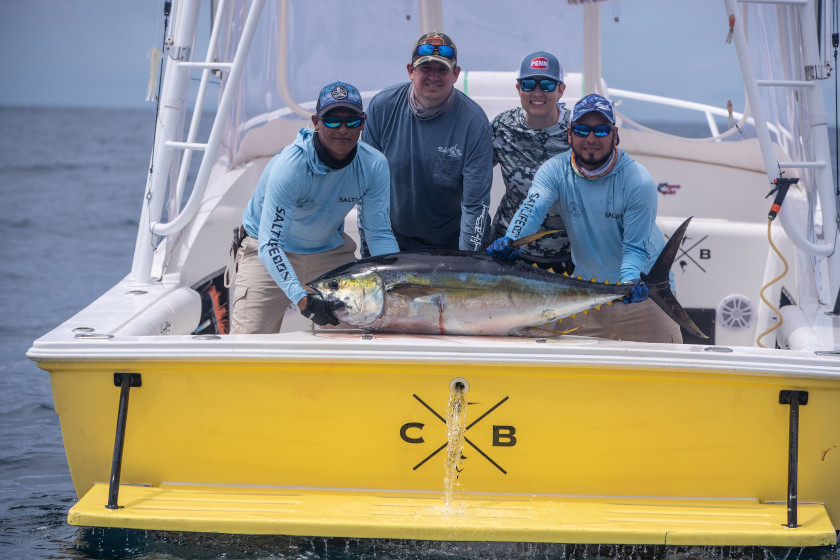
Adrian Gray
There's plenty of big fish to be had in the waters off Costa Rica, some of which qualified for world records that have stood for decades now. For instance, the all-tackle world record for dorado was caught from Papagayo Gulf back in 1976. That 87-pound mark still stands to this day. Costa Rica is also home to the all-tackle records for common and Pacific blackfin snook, plus yellow, Colorado, and Pacific Cubera snapper. In fact, Camacho unknowingly had the new world record Colorado in his hands once without realizing it.
"About four or five months ago, I went out to fish myself, and caught a Colorado snapper a little over 26 pounds, [and the] record was 24 pounds," Camacho said. "But, not knowing it was a record, we ended up releasing the fish and we didn't do anything else."
It wasn't until he started showing the picture around later that someone told him he'd just released a fish with a record-class weight. Camacho only shrugged and laughed it off.
Carlson said Crocodile Bay is building a close relationship with the International Game Fish Association (IGFA) so they can keep a closer eye on the reachable records that may be swimming around int he area. A quick glance at the IGFA's website reveals the country has produced literally dozens of line class and fly fishing tippet records over the years, many of which are quite reachable for the angler who has always dreamed of putting their name in the books.
"We've gone out with some really light tackle and caught a huge variety of species, especially inshore," Carlson said. "If you're not looking for the battle fish, you can catch a huge variety of species down here and keep your rod bent all damn day."
Traveling to Costa Rica

Travis Smola
Ultimately traveling to Costa Rica also isn't quite as difficult as you might expect. From Michigan, I took a flight out of South Bend, Indiana to Atlanta, Georgia, and from there it was a roughly four-hour flight down to the capitol city of San José. The next morning it was a simple matter of jumping on a small domestic flight in a single engine prop plane on Sansa airlines for a short and beautiful one-hour flight to the town to Puerto Jiménez where Crocodile Bay is located.
It's a primarily Spanish-speaking country, but you don't need to be fluent. Everyone at the airports, resorts, and restaurants is well-versed in English and extremely friendly.
Both Carlson and Camacho noted how Crocodile Bay is a bit unique among the list of fishing resorts in Costa Rica, mainly because it offers more activities for anglers who wish to bring their families along for the ride. The resort is host to 30 different daily activities that do not involve fishing for non-angling spouses or children. These include things like horseback riding, chocolate tasting tours, and nature hikes.
"The great thing about Crocodile Bay is all of the different opportunities our guests have to have some fun," Carlson said. "So, a little bit of everything for everybody. And of course, with the new accommodations our fishermen have now at the Botanika, there's a lot more 'Toes in sand, margarita in hand' opportunities for people as well to relax and enjoy themselves."
For anglers who aren't picky about when they come down to fish, Carlson said they regularly offer special rates for cancelations that lead to short-notice openings. It can save an angler a lot of money on the usual rates. The resort is also set to break ground on a new marina in November where they'll have 150 boat slips available. During my visit, they were also updating the grounds, and there are plans to update the boats with new electronics and Penn gear too.
"We're trying to up our game," Carlson said. After spending time at Crocodile Bay, I knew I'd gotten a prime Costa Rican experience, one that folks would likely love to take advantage of once they learned more about it. For more information on curating your own fishing trip at a place like the Crocodile Bay Resort, check out their website and seek out more info on rules and regulations at FishCostaRica.org.
For more outdoor content from Travis Smola, be sure to follow him on Twitter and Instagram For original videos, check out his Geocaching and Outdoors with Travis YouTube channels.
